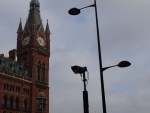On 30 October 2014 on Park Lane, James Bridle was restrained under citizen’s arrest by security guards from the Grosvenor House Hotel. The guards were upset that he was photographing security cameras. Bridle says that when he was subsequently handed over to the law, the Police told him that carrying a camera classed him as suspicious and threatened him with arrest for ‘Going Equipped’ under the 1968 Theft Act.
For the Metropolitan Police, surveillance cameras have become a key technology of control, while those held by members of the public – including artists like Bridle – can pose a potential threat. Photographic theory would understand this in terms of subject and object; to capture something on camera is to be in a position of power, while to be captured is to become vulnerable as a potential target.
Today the internet has amplified the capacity of the lens to subjugate, as machine logic now organises machine imagery. This machine thinking and its formal aesthetics are the subject of Bridle’s work. His essay ‘All Cameras Are Police Cameras’ came out of the documentary walk that included his scrape on Park Lane. In it he considers ‘the privilege of surveillance’, summarises that ‘automated imagery criminalises its subject’, and explains, patiently, that, ‘Cameras no longer see in pictures, but record and process information: the string of numbers on a car license plate, the dimensions of a human face’. The essay is one of four texts he wrote for his online residency, dubbed The Nor, to accompany the Hayward Gallery exhibition ‘MIRRORCITY’.
Speaking at the Royal College of Art later on the day of his near-arrest, the artist, writer, technologist and online publisher, said he structured the residency around walks because he wanted to lighten up. His Drone Shadow series had outlined the shapes of military drones at full scale on the ground in Washington D.C., London, and Istanbul, while his cult project Dronestagram tracked drone strikes around the world – just two of many in a similar vein.
Bridle, a columnist with the Observer and speaker at tech events worldwide, is best known for having coined the term New Aesthetic to describe how things look and feel in our hyper-connected present. The accuracy of his research comes from his academic background in computer science. His creative practice uses technologies to reflect on themselves because he finds our current understanding of the networked world insufficient. Our existing metaphors only obscure the network’s true character, he says, labelling ‘the Cloud’ the worst offender. In the name of clarification Bridle brings certain forms that result from technological development into view. By extension, his reflections also capture the form of those powers behind these developments and their uses.
Drone Shadow 004, adjacent to the Eisenhower Executive Office Building and the West entrance to the White House Part of A Quiet Disposition, a solo show at the Corcoran gallery (June 2013) © James Bridle / booktwo.org

In tune with the thinking of Silicon Valley and MIT, Bridle sees the drive for digital demystification as today’s literacy movement. It was through these same tech research hubs that the US military funded the development of drones. Now it wants to keep control over its progeny. Late last year the Federal Aviation Administration announced it will submit new regulations restricting recreational drone use by September 2015. Such a threat only emphasises their experimental appeal, so expect a rush of drone art in the meantime.
Drones have been around for over a decade but they are presently riding a hype spike. This month’s reports from the 2015 Consumer Electronics Show were dominated by selfie-taking micro helicopters and the like. When a toy drone operated by a US National Geospatial-Intelligence Agency employee crashed in the White House gardens this week, this playful field around miniature drones collided with public consciousness surrounding governmental drone use. Although they are just another category of networked devices, being airborne makes drones interesting to artists just as to the State as they bring aerial perspectives and dislocated agency. Bridle told The Art Newspaper earlier this month: drones are ‘glamorous and seductive objects’ for artists.
 His subject makes Bridle a voice for social critique as well as technology. He finds mirrors of state control in drones and security cameras because that’s what his research reveals through its own form. His texts may be readings but his images present data, drawn from the network, and reposted on the network, to reflect its hidden character to its technologically illiterate participants.
His subject makes Bridle a voice for social critique as well as technology. He finds mirrors of state control in drones and security cameras because that’s what his research reveals through its own form. His texts may be readings but his images present data, drawn from the network, and reposted on the network, to reflect its hidden character to its technologically illiterate participants.
James Bridle is currently participating in the Eyebeam Showcase, New York. He will exhibit at The Photographers’ Gallery, London, from 6 February–15 April and at the Victoria & Albert Museum from 1 April–19 July.
Related Articles
New Horizons: British art and flight (Maggie Gray)
Extraordinary structures: The Wind Tunnel Project in Farnborough (Digby Warde-Aldam)
Post-Surveillance: Suzanne Treister’s riposte to ‘Post-Internet’ art (Digby Warde-Aldam)
Mirrorcity: Glimpsing the digital revolution (Jessica Furseth)







